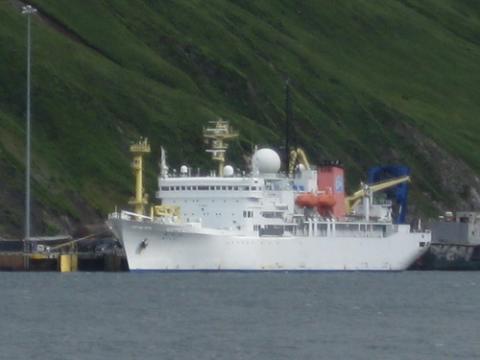Though I am starting this log the day RV Mirai departed Dutch Harbor, Alaska for a 6 week science mission in the Beaufort and Chukchi Seas, it really began the day I left my home port of Victoria on the 22nd. Not a problem flying from Victoria to Anchorage. I stopped for two nights there to meet with the Alaska Maritime Service General Manager Tom Reuter, Nils Andreasson from the Institute of the North and an old USCG friend Barkley Lloyd who is now in the oil spill response business.
I took the opportunity Friday to try to beat the northern propensity to lose luggage and checked my two bags into air freight, priority, for Dutch. They should have arrived the same day I did, Saturday 24, and not be subject to being bumped off the PenAir passenger flight. Right? Silly me. No bags Saturday, or Sunday, or Monday. Promised to be on the next cargo flight by the Ace Air Cargo people departing anchorage on the 1730 flight on the 27th, they got as far as Sand Point apparently. But the flight was delayed and because the hazardous approaches to the Dutch Harbor runway are visual flight rules only, they quite simply ran out of daylight. No bags the night before departure, by then I was really beginning to worry. Still, if they kept the bags on the aircraft, and turned it around quickly on the morning of sailing, I could get them by 1000, requiring perhaps an hour delay in departure of the ship. Can’t say they did. In fact, they off loaded ALL the cargo in Sand Point, scurried back to Anchorage, and wouldnt be flying out of Anchorage until noon, putting the aircraft in Dutch around 1700hrs, way to late for the ship to hang around. We didnt get that word till 0800, by then it was a mad dash to re-supply before sailing. I spent about $800 getting toiletries and clothing to get me through the next six weeks. Of course a few things were forgotten, and of course I will miss my kit that is not here, my binoculars, cold weather gear, knife (imagine a sailor without a knife on his belt), my camera (I do have my iPhone and a pocket camera), my computer connections (thankfully they have wifi now so email and connection to LAN is possible – but no GPS inputs directly to the laptop), and a myriad of other kit I will come to miss. Most of my books are on my iPad or kindle and I am glad I thought to bring chargers for all that kit on my carry on. But at least I am here and the voyage has started.
Now to the details, the Mirai is a 130m, 8600GT research ship, operated by NYK’s subsidiary Global Ocean Development Inc (GODI) for Japan Agency for Marine-Earth Science and Technology (JAMSTEC). She was originally built as a nuclear powered test ship Mutso but was soon converted to diesel electric propulsion in 1997. There are 13 oceanographic laboratories, 3 meteorological laboratories and she is fitted with a 22 ton A-Frame, 11 ton gallows crane, 7 observation winches, 3 traction winches, a 3 ton articulated deck crane, a 10 ton job deck crane, a rosette water sampling system and a complete integrated onboard data management system. She has accommodations for 34 crew, and 56 scientists and support staff. The Ice Navigator is hired through their American Agents, Alaska Maritime Services by GODI.
We are heading north from Dutch Harbor, the test rosette cast, basic ship familiarization and emergency drills behind us. Our first science station is several days away on 31 August in the Bering Strait. Until then it is continue to watch the ice situation. Martech Polar staff are collecting and forwarding on NOAA; National Ice Centre; Canadian Ice Service; Russian Arctic and Antarctic Research Institute; and Norwegian Met Office ice charts. Each has its own advantages and disadvantages, and not all will be of value on any given day, but this will be discussed in a later post. Right now its not looking that good for covering the entire planned science program. The ice melt this year has not been as rapid and extensive as past years and so far many of the science stations are still covered by ice.

